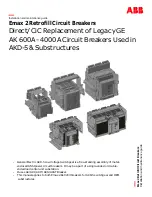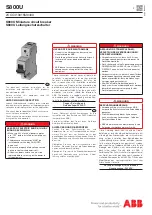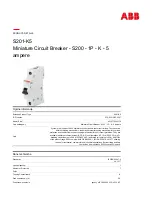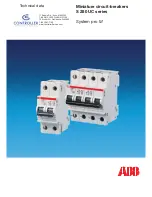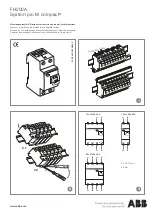
(13)
DIR 1000587R0002 (Version 02)
2.8. Troubleshooting
2.8.1. Troubleshooting
The following table lists a series of typical service conditions, to help you understand and solve hypothetical faults or malfunctions.
NOTES:
1. Before consulting the following table, check for any optical signals provided by the LEDs.
2. FN indicates the normal operation of the LSIG.
3. If the following suggestions fail to solve the problem, please contact the AB assistance service.
N° Situation
Possible causes
Suggestions
1 The trip test cannot be run
1. The busbar current is > 0
2. The TC is not connected
3. Battery unit is not connected
1. Normal operation (FN)
2. Check TC connection (see par. 2.6.3)
3. Connect the battery unit
2 Trip times lower
than expected
1. Threshold too low
2. Curve too low
3. Incorrect neutral selection
1. Correct threshold
2. Correct curve
3. Correct neutral adjustment
3 Trip times higher
than expected
1. Threshold too high
2. Curve too high
3. Curve type "t=k/I
2"
4. Incorrect neutral selection
1. Correct threshold
2. Correct curve
3. Select curve type "t=k"
4. Correct neutral adjustment
4 Rapid trip, with I3=Off
Iinst tripped
FN short-circuit with high I
5 Earth fault current beyond
threshold
G function automatically inhibited but no
trip occurs
FN
6 Expected trip does not happen Function OFF
FN enable protection function
7 LEDs irregularly turned on
see par. 2.3.2
8 Unexpected trip
see par. 2.3.2
9 L LED (orange) fl ashing
FN
2.8.2.
In the case of a fault
ATTENTION: If the LSIG is suspected of being faulty, if there are signs of malfunctions or it has generated an
unexpected trip, we advise you to strictly follow the recommendations below:
1. Press the “i Test” button (within 48 hours of CB opening or within 24 hours if the operating temperature is in the -40°..-25°
range) and make a note of the led that comes on, the type of CB, the number of poles, any accessories connected, In, Serial
Number. After 48 or 24 hours, depending on the case, the data is saved. Just the LED display is inhibited.
2. Prepare a brief description of the opening (what LEDs were displayed?, when did it happen?, how many times?, was it always
under the same conditions? what type of load? what current? is the event reproducible?).
3. Send/communicate all the information collected, together with the circuit diagram for the circuit-breaker, to your Rockwell
Automation Technical Support Team, for analysis.
ATTENTION: Letting a Circuit-Breaker run with a fault that has not been remedied may lead to an apparatus
malfunction or shutdown. Removing the Circuit-Breaker from service immediately until it can be inspected and
evaluated, will minimize the risk of damage to equipment or personel.





























